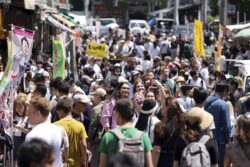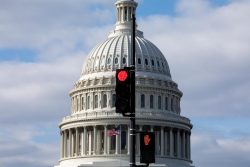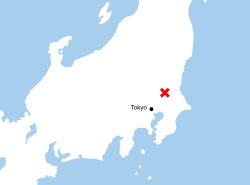17:03 JST, April 7, 2025
Fake sexual images and videos created through misuse of generative artificial intelligence are starting to cause serious harm in Japan. Examination of measures to prevent such harm must be accelerated.
With the advancements in generative AI, now anyone can easily make sophisticated fake sexual images and videos. Many websites can be found on the internet that show how to create such material. This seems to be a drawback of the evolution of AI technology.
According to a survey by a U.S. security company, about 96,000 fake videos were confirmed online in 2023, more than five times the number in 2019. Of these, 98% had sexual content.
Many victims of these fakes are celebrities, but there also have been cases where portraits and other images of acquaintances and schoolmates obtained from yearbooks have been used without their knowledge. The risk of AI technology being misused is drawing nearer to people’s everyday lives.
Once fake images are circulated online, it is difficult to delete all of them. People who have had their image used without their knowledge live in fear, not knowing when someone will see the fakes, or who will see them, and they become traumatized. This situation cannot be left unaddressed.
Overseas, there have been moves to prohibit the creation and possession of fake sexual images. In Japan, on the other hand, while people have been charged with a criminal offense when they have caused real harm, such as through defamation, no law prohibits the creation of fake images.
The Tottori prefectural government has enacted a revised ordinance on the promotion of the healthy development of youths, which defines sexual images and videos created from photos of children’s faces using generative AI as child pornography, prohibiting the creation and distribution of such material.
The Law on Punishment of Activities Relating to Child Prostitution and Child Pornography and on the Protection of Children applies only to cases where a victim exists, but it is difficult to verify there is a victim when it comes to AI-generated fake images. For this reason, the prefectural government’s ordinance applies regardless of whether there is an existing victim or not.
However, these issues should primarily be handled by the central government. A panel of experts for the central government that is studying AI-related legislation, among other issues, has also raised the issue of fake sexual images as a risk.
One bill on generative AI, currently being debated in the Diet, states that the central government will disclose the names of AI service providers, among other relevant entities, in the event of a serious infringement of people’s rights. However, there are no penalties. It is important to further debate whether this will be sufficient to prevent harm.
It is also essential to strengthen online monitoring in collaboration with the private sector and to improve consultation services. Online platform operators also need to take thorough measures, such as deleting fake images of people that have been posted without the person’s consent.
Education at school and at home is also important. Young people should be taught that the creation and sharing of fake sexual images is a serious violation of personal rights.
(From The Yomiuri Shimbun, April 7, 2025)
"Editorial & Columns" POPULAR ARTICLE
-

Violations of Subcontract Law: Major Automakers Must Eliminate Old Practices
-

Local Governments’ Tax Revenues: Devise Ways to Correct Imbalances in Tax Sources
-

5 Japanese Business Dinner Mistakes to Avoid — and What They Taught Me About Business in Japan
-

Heavy Rains in Asia: Support for Victims, Flood-Control Measures Urgently Needed
-

New Nuclear Threat: China Seeking to Follow U.S., Russia in Military Expansion
JN ACCESS RANKING
-

Keidanren Chairman Yoshinobu Tsutsui Visits Kashiwazaki-Kariwa Nuclear Power Plant; Inspects New Emergency Safety System
-

Imports of Rare Earths from China Facing Delays, May Be Caused by Deterioration of Japan-China Relations
-

University of Tokyo Professor Discusses Japanese Economic Security in Interview Ahead of Forum
-

Japan Pulls out of Vietnam Nuclear Project, Complicating Hanoi’s Power Plans
-

Govt Aims to Expand NISA Program Lineup, Abolish Age Restriction





















